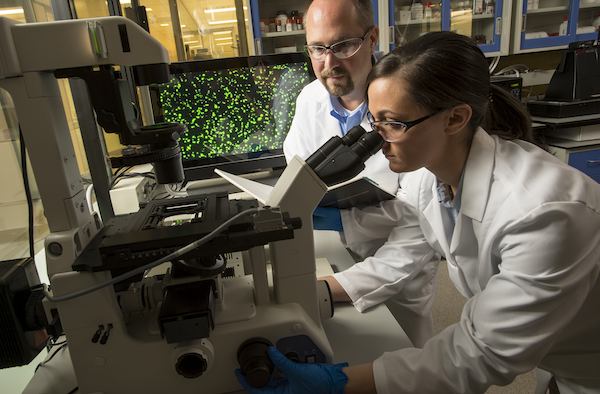
[Image above] Corning glass scientists working on antimicrobial ion-exchange touchscreen glass. Credit: Corning Intl
I’ve reported regularly on Corning’s concern that young materials scientists coming out of universities will have the skills they need. This seems natural for a company that relies on brains rather than brawn to maintain its competitiveness.
Over the past year, Corning has methodically unfurled a strategy to not just raise the issue, but address them proactively and constructively (complaining is easy, workable solutions take thought and discipline). And while Corning’s is motivated by self-interest, their public approach benefits the whole glass industry. After all, improving the talent pipeline does not guarantee that Corning and candidates will consummate an employment deal.
Let’s look at steps in the strategy.
January 2014—Glass research scientist John Mauro and colleagues publish “Glass Science in the United States: Current Status and Future Directions,” wherein they argue that too little university-based research addresses industrially relevant glass problems. Analyzing literature publication and NSF funding level trends, they conclude that under the current situation it is, “… less likely that future researchers in this field will have the required skills and expertise needed to enable the US glass industry to compete globally.” They offer about a dozen suggestions for “industrially relevant” research topics.
June 2014—Corning invites about 50 researchers—mostly professors—to its first-ever Glass Research Summit. The goal was to revitalize interest in glass research at universities and to find collaborators from the academic ranks.
December 2014—After setting the stage and engaging the community, Corning revealed the next step in its strategy last week with the announcement of a new sabbatical program to give academic researchers the opportunity to work with Corning scientists at the company’s state-of-the-art Sullivan Park research center.
According to John Mauro—point man on this initiative, as he was on the other elements of the strategy—the objective is to strengthen relationships between Corning and university researchers. He says in an email, “The Gordon S. Fulcher Sabbatical Program emerged as one of the actions from our Corning Glass Summit in June. We plan to solicit proposals each year for sabbaticals during the following calendar year. The winning researcher will earn the honor of being the Gordon S. Fulcher Distinguished Researcher for that year.”
Mauro provided some background on naming the sabbatical for Gordon Fulcher, too. “We decided to name this sabbatical in honor of famed Corning researcher Dr. Fulcher owing to his highly influential work that impacted the entire academic research community across all fields of study. Dr. Fulcher is well known to the glass community for his seminal work describing the visocity of glass-forming liquids,” he says.
Interestingly, Fulcher’s influence extends beyond glass into every field of scientific inquiry. Mauro explains, “What is less well known is that he invented the modern system of abstracting used at scientific conferences and in peer-reviewed journals … while serving as editor of Physical Review. It was later adopted by the League of Nations, recommending that all scientific publications adopt the Fulcher system of abstracting.”
Eventually, Corning would like to extend the program and offer Corning scientists an opportunity for a university-based sabbatical.
Here are the details from Mauro.
“Corning Incorporated is delighted to offer you the opportunity to apply for its inaugural Gordon S. Fulcher Sabbatical Program. The program is named after famed Corning glass scientist, Dr. Gordon S. Fulcher, who is responsible for pioneering research on the electronic melting of refractory materials and introducing the Fulcher equation for viscosity. Information on the life and impact of Dr. Fulcher can be found at: http://journal.frontiersin.org/Journal/10.3389/fmats.2014.00025/full
The program would offer professors the opportunity to engage closely with Corning scientists on research topics of mutual interest—especially those related to fundamental science. One external researcher will be selected to participate in the inaugural program, which is slated to commence in 2015 at Corning’s Sullivan Park research lab and last anywhere from six months to one year.
If you’re interested in applying for this program, please prepare a proposal with the following information (not to exceed three pages):
- Objectives for the sabbatical including:
- Research objectives
- Broader impact statement (including nontechnical aspects, such as how the sabbatical will engage students)
- Logistical details, including timing of the sabbatical
- Budget estimate for expenses not covered by your university
- Approximate timeline of research
- Support letter from a Corning sponsor/collaborator (optional)
Completed proposals should be sent to John Mauro at mauroj@corning.com by December 31, 2014, in order to be considered for the 2015 program. Please note that sabbatical funding is typically provided by the university, and intellectual property (IP) terms would need to be negotiated between the university and Corning.”


